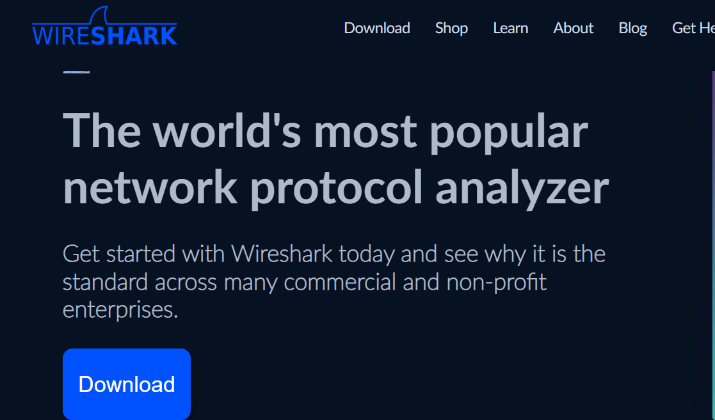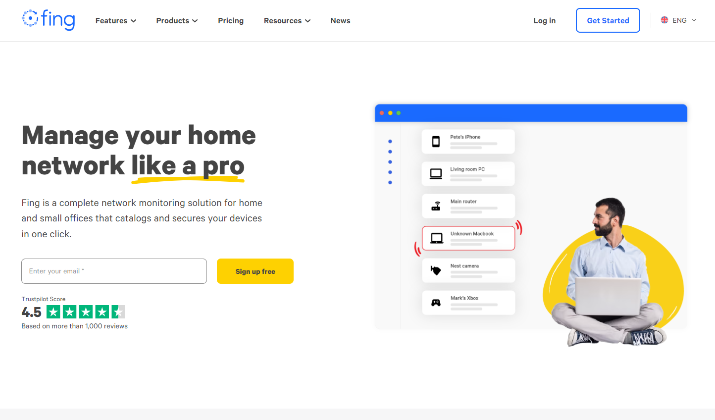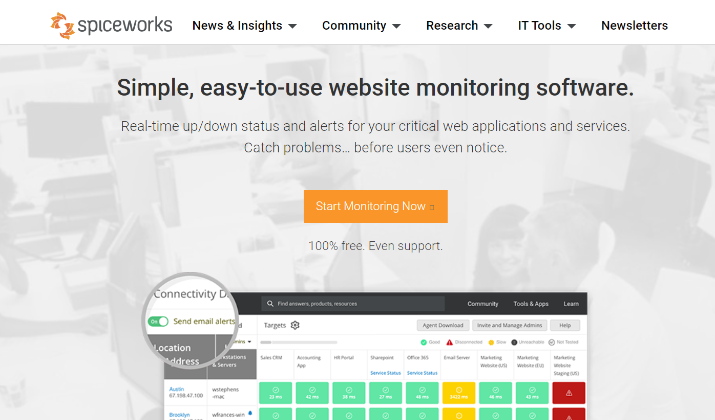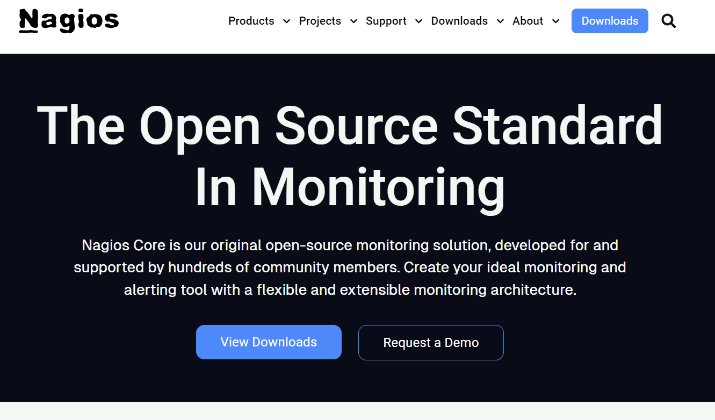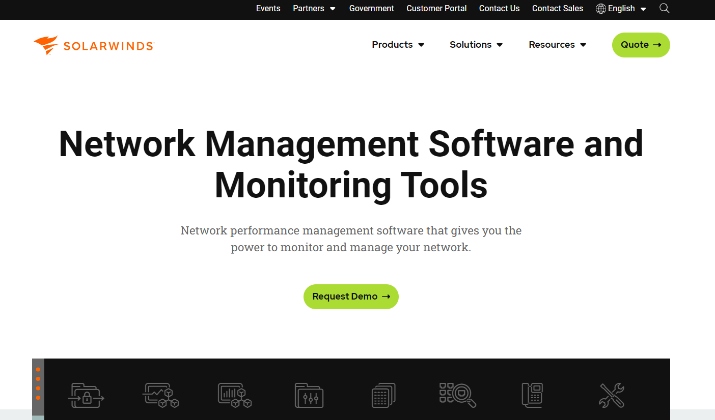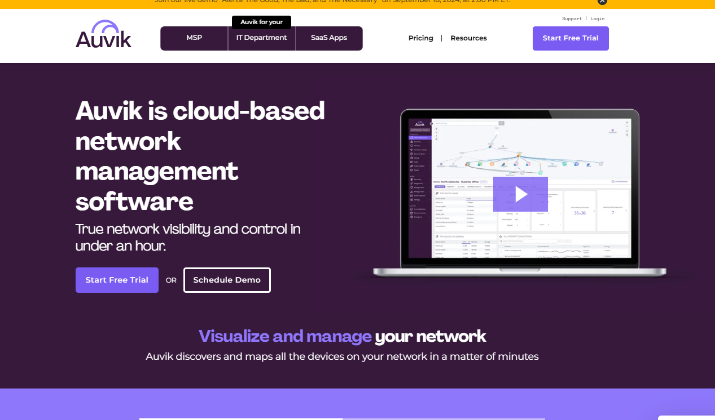Try to picture this – you are walking into your home or small business, and feeling an overwhelming sense of calm as all your devices seamlessly connect to the Wi-Fi, allowing you to focus on what truly matters.
This harmonious experience is often taken for granted until the networks falter.
The need for reliable network management tools has never been more critical, especially since the discontinuation of Cisco’s Network Magic in 2013.
As a user, you might still feel the void left by its absence, struggling to find an effective solution that combines simplicity, efficiency, and robust monitoring capabilities.
Thanks to the array of network management tools currently available, it’s easy to explore the best Network Magic alternatives that can help restore that ease of mind.
This article aims to guide you through the various alternatives, emphasizing their key features, strengths, and how they can fill the gap left by Network Magic.
Quick Summary
If you previously relied on Network Magic, consider investigating alternatives such as:
- GlassWire – A network monitoring tool that tracks bandwidth usage, monitors network activity, and offers security alerts.
- Wireshark – A popular open-source packet analyzer for network troubleshooting, analysis, and education.
- NetSpot – A wireless network survey app that helps with WiFi troubleshooting and optimization.
- Fing – A mobile app that allows you to discover devices connected to your network, perform speed tests, and troubleshoot issues.
- Spiceworks – A free network management and monitoring tool that also provides IT asset management and help desk features.
- Nagios – An open-source network monitoring system that provides alerts on issues related to hosts and services.
- Zabbix – Another open-source tool that offers monitoring services for networks, servers, and applications.
- SolarWinds Network Performance Monitor – A comprehensive tool for real-time network performance monitoring and diagnostics.
- PRTG Network Monitor – A user-friendly network monitoring solution for tracking bandwidth, devices, and applications.
- Auvik – A cloud-based network monitoring and management software for real-time troubleshooting.
Exploring these alternatives can lead to better management of your networking needs. Join us as we discuss each of these alternatives in the coming sections.
About Network Magic & It’s Alternatives
Cisco Network Magic was a network management tool designed to simplify the setup, monitoring, and management of home and small office networks. It came with features such as automated device detection, enhanced security, and parental controls.
The discontinuation of support for Network Magic has created a gap for users who relied on its comprehensive network management features.
As a result, there is an urgent need to explore an overview of Network Magic alternatives that can fulfill similar roles in effective network management.
You may find it challenging to pinpoint tools that deliver the same level of automation and insight once provided by Network Magic, such as automatic network mapping, IP address reporting, and device performance monitoring.
This is exactly why we are here to help.
Let’s explore the top 10 Network Magic alternatives designed to enhance your network management, monitoring, and security capabilities.
1. GlassWire
GlassWire is a network monitoring and security tool that provides users with detailed insights into their network activity, including data usage and potential threats.
It is designed to help individuals and businesses monitor their network performance and security in real time.
Here is a look into its main features:
- Network Monitoring: Provides real-time monitoring of network traffic, allowing users to see which applications are using the most bandwidth.
- Firewall Management: Includes a built-in firewall that allows users to block or allow applications from accessing the network.
- Alerts and Notifications: Sends alerts for unusual network activity, helping to detect potential security threats.
- Data Usage Tracking: Tracks data usage by application and device, enabling users to compare their usage with ISP reports.
- Historical Data: Offers historical data on network activity, allowing users to review past usage trends.
- Multiple Device Support: Can monitor multiple PCs simultaneously, making it suitable for both personal and business use.
- User-Friendly Interface: Features an intuitive interface that makes it easy to navigate and understand network activity.
- Remote Monitoring: Allows users to monitor their network remotely, providing flexibility for managing multiple devices.
In comparison to Network Magic, GlassWire is generally considered more robust and feature-rich, particularly in its real-time monitoring and firewall capabilities.
2. Wireshark
Wireshark is a powerful, open-source network protocol analyzer that enables users to capture and interactively browse traffic on a computer network.
It is widely used for network troubleshooting, analysis, software and communications protocol development, and education.
It comes with multiple benefits such as:
- Cross-Platform Compatibility: Runs on Windows, Linux, macOS, and other operating systems.
- Live Capture and Offline Analysis: Allows real-time packet capturing as well as analysis of previously saved capture files.
- Deep Packet Inspection: Provides detailed visibility into the contents of packets, facilitating comprehensive analysis of network communications.
- Advanced Filtering: Users can apply complex display filters to isolate specific traffic based on protocols, ports, and IP addresses.
- Statistical Analysis: Offers various statistical tools and graphical representations to visualize network traffic and identify anomalies.
- Color Coding: Uses color coding to differentiate between various packet types and statuses, enhancing readability.
- Data Export Options: Supports exporting captured data in multiple formats (e.g., XML, CSV, plain text) for easier sharing and reporting.
- Customizability: Users can create custom display filters, plugins, and dissectors to tailor the tool to specific needs.
- Protocol Support: Extensive support for a wide range of network protocols, making it versatile for different network environments.
- Educational Use: Serves as a valuable learning tool for understanding network protocols and traffic analysis.
Wireshark is generally considered superior to Network Magic due to its extensive feature set and flexibility in network analysis, making it more suitable for professional and technical users.
3. NetSpot
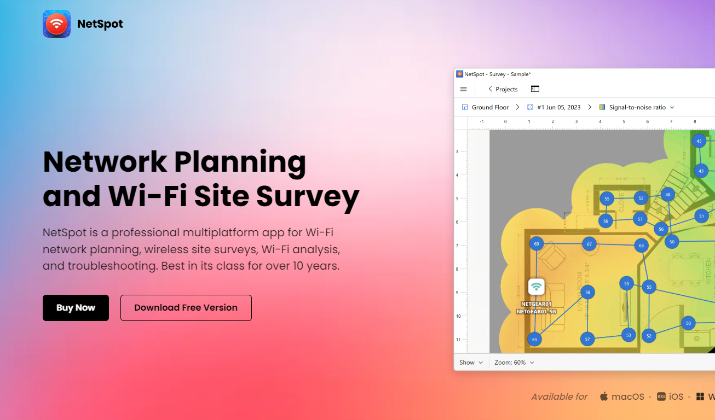
NetSpot is a comprehensive application designed for WiFi network analysis, planning, and troubleshooting.
It is suitable for both professionals and casual users, providing tools to visualize WiFi coverage, perform wireless site surveys, and optimize network performance.
It offers numerous benefits such as:
- Inspector Mode: Quickly analyzes nearby wireless networks, displaying details like SSID, BSSID, signal strength, and channel usage.
- Survey Mode: Generates detailed heatmaps of WiFi coverage by mapping signal strength across a designated area, helping to identify weak spots.
- Planning Mode: Assists in designing new WiFi networks by simulating coverage based on the layout of the area and the placement of access points.
- Data Export: Allows users to export collected data in various formats (CSV, PDF, PNG) for further analysis or reporting.
- Multi-Platform Support: Available on macOS, Windows, and Android, making it accessible for a wide range of users.
- User-Friendly Interface: Features a contemporary design that is responsive and easy to navigate, with options to switch between table and chart views.
- Real-Time Monitoring: Provides real-time insights into WiFi signal strength and interference, enabling immediate troubleshooting and optimization.
- Heatmap Generation: Offers over 20 types of heatmaps to visualize WiFi coverage and performance, aiding in effective network planning.
- Predictive Surveying: Allows users to upload area maps and simulate network coverage before installation, reducing trial and error.
NetSpot can be rated more advanced and versatile than Network Magic, particularly in its analysis and planning capabilities, making it a better choice for comprehensive WiFi management.
4. Fing
Fing is a network scanning and monitoring tool designed for both home users and professionals.
It allows users to discover devices on their network, monitor network performance, and troubleshoot connectivity issues.
Fing is notable for powerful features that include:
- Device Discovery: Automatically identifies all devices connected to the network.
- Network Performance Monitoring: Provides insights into network speed and performance metrics.
- Network Troubleshooting: Offers tools to diagnose connectivity issues and identify network problems.
- Security Alerts: Notifies users about unauthorized devices or potential security threats.
- User-Friendly Interface: Designed for ease of use, making it accessible for non-technical users.
- Remote Monitoring: Allows users to monitor their network remotely through mobile apps.
- Wi-Fi Network Analysis: Analyzes Wi-Fi networks to optimize performance and coverage.
- Customizable Notifications: Users can set alerts for specific network events or changes.
When compared to Network Magic, Fing is a better choice due to its modern features, continuous updates, and better overall performance, especially since Network Magic has been discontinued and is no longer supported.
5. Spiceworks
Spiceworks is a network management tool designed to help IT professionals monitor and manage their networks efficiently.
It offers a range of features that cater to both small and medium-sized businesses, providing tools for device discovery, inventory management, and network monitoring.
It offers a multitude of capabilities that include:
- Device Discovery: Automatically detects devices on the network and compiles an inventory with details such as IP address, hostname, MAC address, and operating system.
- Network Monitoring: Provides real-time monitoring of network performance and device status.
- Cloud-Based Access: Users can access the dashboard via any web browser, facilitating easy management from different locations.
- User-Friendly Interface: Designed to be intuitive, making it accessible for users with varying levels of technical expertise.
- Reporting and Exporting: Allows users to generate reports and export data to CSV files for analysis and record-keeping.
- Security Features: Communications between the Spiceworks server and devices are encrypted, ensuring data security.
- Community Support: Offers access to a community forum for troubleshooting and sharing best practices among users.
Although Spiceworks can be more complex than Network Magic, it is a capable alternative that works on multiple operating systems, including Windows, macOS, Ubuntu, and Debian.
6. Nagios
Nagios is a widely recognized open-source network management tool that specializes in monitoring computer systems, networks, and applications.
Established in 1999, it has become a standard in the industry due to its flexibility, extensibility, and robust community support.
Nagios provides both free and paid versions, with Nagios Core being the open-source option and Nagios XI offering enhanced features for enterprise environments.
It is known for its powerful capabilities such as:
- Comprehensive Monitoring: Monitors a wide range of devices, services, and applications.
- Extensible Architecture: Supports numerous plugins and APIs for customization and integration with other tools.
- Agentless Monitoring: Capable of monitoring systems without requiring agents installed on every device.
- Rapid Alerting System: Provides quick notifications for network outages and protocol failures via email, SMS, and other methods.
- Scalability: Suitable for large and complex IT environments, adapting to business growth without performance compromise.
- Community Support: A vibrant community contributes to a rich ecosystem of plugins and extensions.
- Cost-Effective: Offers a free version, making it accessible for various budgets.
- Robust Logging: Maintains a resilient database and log system for tracking performance and issues.
Although Nagios is more complex to set up and use compared to Network Magic, it excels in flexibility and comprehensive monitoring capabilities.
7. Zabbix
Zabbix is an open-source, enterprise-class distributed monitoring solution designed to monitor and track the performance and availability of IT infrastructure in real-time.
Some of Zabbix’s key features and strengths include:
- Metric collection from multiple sources using agents and agent-less methods
- Problem detection with root cause analysis and trend prediction
- Visualization through dashboards, graphs, network maps, and reports
- Notification via multiple channels and options
- Security with encryption and authentication support
- Auto-discovery of devices
- Distributed monitoring with centralized control
- Extensibility via Zabbix API
Zabbix is better than Network Magic in that it is a comprehensive, enterprise-grade network monitoring solution with a wide range of advanced features, while Network Magic was a consumer-oriented network utility with basic functionality.
8. SolarWinds
SolarWinds Network Performance Monitor (NPM) is a comprehensive network management tool that provides extensive monitoring and management capabilities for network performance.
It is recognized for its user-friendly interface and powerful features that help organizations maintain network health and performance.
Here are its key features:
- Multi-Vendor Network Monitoring: Supports various devices from different manufacturers, enabling broad compatibility.
- Intelligent Maps: Visual representations of network topology that simplify monitoring and troubleshooting.
- Automated Network Discovery: Quickly identifies and maps network devices without manual input.
- Advanced Alerting: Customizable alerts for performance issues, ensuring timely responses to network problems.
- End-to-End Monitoring: Monitors the performance and availability of all network devices continuously.
- Latency Testing: Regular checks on network latency to identify potential issues.
- Fault and Performance Tracking: Real-time tracking of network faults and performance metrics.
- In-Depth Reporting: Comprehensive reports on network performance, helping in analysis and decision-making.
- Scalability: Designed to grow with the organization, accommodating increasing network demands.
- User-Friendly Interface: A clean, intuitive interface that presents data clearly, enhancing usability.
- Integration Capabilities: Easily integrates with various third-party applications and services.
Compared to Network Magic, SolarWinds NPM offers a significantly more robust and feature-rich solution, making it a superior choice for network management.
9. PRTG Network Monitor
PRTG Network Monitor is a comprehensive network management tool developed by Paessler GmbH, designed to monitor various aspects of IT infrastructure, including network devices, servers, applications, and bandwidth.
It provides real-time insights into network performance and health, making it suitable for organizations of all sizes.
It is popular due to its multiple benefits that include:
- Comprehensive Monitoring: Monitors devices, applications, bandwidth, and network traffic across local and wide area networks.
- Sensor-Based Architecture: Utilizes a sensor-based model that allows for extensive customization and scalability, with hundreds of preconfigured sensors available.
- Auto-Discovery: Automatically identifies and maps network devices, streamlining the setup process.
- Customizable Dashboards: Offers customizable maps and dashboards for visualizing network status and performance metrics.
- Flexible Licensing: Provides a flexible licensing model based on the number of sensors, allowing organizations to pay only for what they need.
- Real-Time Alerts: Features a robust alerting system that notifies users of unusual network activity or performance issues.
- Bandwidth Monitoring: Assesses bandwidth usage through various methods, including SNMP and flow monitoring.
- Cloud and On-Premises Options: Available as both a cloud service and an on-premises solution, accommodating different deployment preferences.
- In-Depth Reporting: Generates detailed reports and logs for analysis and troubleshooting.
- Integration Capabilities: Can integrate with various third-party tools and services for enhanced functionality.
PRTG offers a broader range of features and capabilities than Network Magic, making it a more powerful and flexible solution for network monitoring and management.
10. Auvik
Auvik is a cloud-based network management tool designed to provide comprehensive visibility and control over network infrastructure.
It is particularly beneficial for internal IT teams and managed service providers (MSPs), enabling them to automate various network management tasks.
Here is a look at its benefits:
- Automated Network Discovery: Quickly identifies and maps all devices on the network.
- Traffic Analysis: Utilizes machine learning for advanced traffic insights, including visibility into encrypted traffic.
- Configuration Management: Tracks configuration changes and automates backups for device configurations.
- Remote Access Tools: Includes secure remote access features such as an integrated terminal and tunneling client for troubleshooting.
- Custom Alerts: Provides customizable alerts and monitoring profiles to keep network administrators informed.
- Integration Capabilities: Supports integration with IT service desks like ServiceNow and offers a REST API for custom integrations.
- Scalability: Designed to handle multi-vendor environments and is scalable for distributed networks.
- Security Features: Offers support for Single Sign-On (SSO), two-factor authentication (2FA), and granular access controls.
Auvik offers more advanced features than Network Magic, including automated network discovery and machine learning-driven traffic analysis, making it a more robust solution for network management.
Finding an effective network management solution is critical for maintaining a seamless internet experience.
The alternatives reviewed in this article, each bringing unique strengths to the table, highlight how modern network management solutions cater to a range of specific needs.
Whether you prioritize ease of use, advanced performance analytics, or robust security features, there is a suitable choice for you.
Embracing these contemporary network management solutions positions you to tackle current challenges effectively, paving the way for a more streamlined network experience.
As you consider the alternatives presented, take the time to assess your unique requirements to make an informed decision that best aligns with your networking goals.



